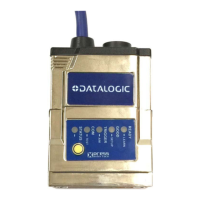Why is the TRIGGER LED blinking, but the Datalogic Matrix 210N transmits no result?
- JJeff DanielsSep 12, 2025
Check the Code Collection parameters on the Reading Phase step and the Data Formatting parameters on the Data Formatting step.

Why is the TRIGGER LED blinking, but the Datalogic Matrix 210N transmits no result?
Check the Code Collection parameters on the Reading Phase step and the Data Formatting parameters on the Data Formatting step.
What to do if DL.CODE Installation Autorun or Start.hta doesn’t run for Datalogic Card Reader?
Check Windows settings to see if Autorun is disabled. Associate the file type .hta with the Microsoft HTML Application host mshta.exe in Windows\System32.
| Storage temperature (T-T) | -20 - 70 °C |
|---|---|
| Operating temperature (T-T) | 0 - 50 °C |
| Input voltage | 10 - 30 V |
| Power source type | DC |
| Power consumption (typical) | 4.5 W |
| Certification | AIM DPM, ISO/IEC 15416 |
| Product color | Blue |
| Housing material | Aluminium, Plastic |
| International Protection (IP) code | IP65 |
| Type | Barcode module bar barcode readers |
| Sensor type | CMOS |
| Scanner type | 1D/2D |
| Maximum scan area | 80 x 50 mm |
| Linear (1D) barcodes supported | - |
| Optical sensor resolution (W x H) | 780 x 480 pixels |
| 2D (matrix & stacked) barcodes supported | Aztec Code, Data Matrix, MaxiCode, Micro QR Code, QR Code |
| Ethernet LAN | Yes |
| PC connection | RJ-45 |
| Connectivity technology | Wired |
| Depth | 25 mm |
|---|---|
| Width | 50 mm |
| Height | 45 mm |
| Weight | 204 g |
Describes typographic and formatting conventions used in the manual.
Lists other Datalogic documents for further details.
Explains how to access online support and resources.
Lists patents covering the product.
Details Electromagnetic Compatibility requirements for the reader.
Information on power requirements and safety guidelines.
States compliance with applicable European directives.
Details compliance with Federal Communications Commission rules.
Describes methods for connecting the reader via Ethernet, USB, or Serial.
Explains how to mount and position the reader for optimal reading.
Guides X-PRESS configuration for readers with liquid lens technology.
Guides X-PRESS configuration for readers with fixed focus optics.
Provides instructions for installing the DL.CODE software.
Details how to discover devices connected via Ethernet.
Details how to discover devices connected via USB.
Details how to discover devices connected via Serial port.
Guides the process of configuring the reader's settings.
Guides how to enter and use the reader's test mode for performance checks.
Describes partial configuration of the reader via a host computer.
Describes the features and benefits of the Matrix 210N reader.
Explains the function of the reader's LEDs and keypad.
Describes the high-speed ID-NET communication interface.
Details the reader's intuitive HMI interface and functions.
Explains how to interpret the reader's model numbers and characteristics.
Lists available accessories that can be used with the reader.
Shows practical use cases and applications of the reader.
Discusses external lighting options and their connection.
Lists all items included in the product package.
Provides the physical dimensions of the reader models.
Explains how to mount and position the reader using brackets.
Explains power supply connections and requirements for the reader.
Describes the main serial interface connections and parameters.
Details the ID-NET interface, cables, and termination requirements.
Describes the auxiliary RS232 interface connections.
Explains the reader's input connections and their functions.
Explains the reader's output connections and their functions.
Details how to connect and control external lighting systems.
Describes the onboard Ethernet interface and protocols.
Details RS232 PC host interface pinouts and test cable creation.
Illustrates typical reader connection setups via Ethernet.
Illustrates typical reader connection setups via Serial interface.
Illustrates typical reader connection setups via Fieldbus.
Describes pass-through layout configurations for multi-device networks.
Details ID-NET Multidata network layouts.
Details ID-NET Synchronized network layouts.
Illustrates typical reader connection setups via USB.
Details reading features for fixed focus models.
Explains how to calculate the reader's Field of View.
Provides diagrams for typical Field of View performance.
Explains how to calculate the maximum line speed.
Lists system requirements for the DL.CODE software.
Guides the reader configuration process using DL.CODE.
Configures pass-through settings for multi-device setups.
Guides setting up ID-NET Master/Slave networks.
Configures Multidata ID-NET networks.
Configures Synchronized ID-NET networks.
Guides verification of synchronized network setup.
Explains backup and restore procedures using DL.CODE.
Explains how to interpret diagnostic alarms from the ID-NET network.
Details how to view reading performance statistics.
Configures and interprets messages from the BM150 display module.
Offers general advice for troubleshooting common issues.
Explains the 25-pin D-sub connector pinout for connections.
Details the M12 Ethernet connector pinout and specifications.
Explains ID-NET network termination requirements.
Explains the reader's input connections on the 25-pin connector.
Explains the reader's output connections on the 25-pin connector.
Shows how to build a simple interface test cable.